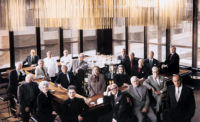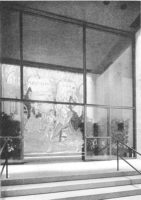The Four Seasons Standoff














Architects & Firms
UPDATE May 19, 2015: At a public hearing this afternoon, New York City’s Landmarks Preservation Commission decided against approving alterations submitted by RFR Holdings to the interiors of the Four Seasons restaurant in the Seagram Building. On behalf of RFR, Selldorf Architects had proposed two modifications that became lightning rods for the testimonies: making operable the upper tier of French walnut panels in the Pool Room’s mezzanine and removing the cracked glass and bronze partition in the Grill Room. (Details below). The Commission did, however, accept changing the color of the carpet.
Speaking against the scheme were Phyllis Lambert, who played significant role in the Seagram Building’s conception; Edgar Bronfman, Jr. (a major stakeholder in the restaurant); Barry Bergdoll, the historian and curator; Ricardo Scofidio, principal of Diller Scofidio + Renfro; David Fishman of Robert A.M. Stern Architects (on behalf of Stern); along with other preservationists and architects. All concurred the proposals risked endangering the essence of the architectural experience—including Landmarks commissioners, such as Frederick Bland of Beyer Blinder Belle Architects & Planners.
But first, an important related issue: In addition to modifications to the physical setting of the Four Seasons, Rosen and his firm RFR Holding, the owner of the Seagram Building since 2000, have indicated to Four Seasons’ owners Julian Niccolini and Alex von Bidder that RFR will take over the space when the lease expires in 2016. Last year, it was reported that Rosen wanted to want to triple the rent. Now it seems more likely he wants to say goodbye. “Aby has no interest in renewing,” Niccolini says. “He has made it very clear in language I can’t repeat.” (RFR says “A final decision has not been made.”)
Before Rosen hired Selldorf Architects, New York architect Belmont Freeman had begun piecemeal restoration work for Niccolini and von Bidder in 2009. His commission came at the recommendation of Phyllis Lambert, the architect who had convinced her father Samuel Bronfman, owner of the Seagram Company, to hire Mies van der Rohe to design the tower. Then last month, Lambert and Freeman learned of Selldorf’s and Rosen’s plans. Lambert, whose family is a backer of the restaurant, says she learned of the proposals going before the LPC from New York City preservationist Theodore Grunewald, who says he religiously reads the commission’s calendar. The hearing was rescheduled to May 19 from its mid-April date after another interested party, the New York Landmarks Conservancy, complained it had not been advised either. The non-profit Conservancy has jurisdiction on exterior alterations due to an easement Rosen signed over to it in 2007 in return for a tax break. Since Rosen and Selldorf also were proposing to redesign the canopies on East 52nd and 53rd Streets (the latter is the entrance to Johnson’s more casual Brasserie redone in 2000 by Diller Scofidio + Renfro), the Conservancy needed to be consulted before the LPC hearing.
After the rescheduling, Lambert and Freeman met with Rosen and architects from Selldorf’s office (she was out of town) to express concerns over the proposals they had been shown. As a result, the initial drawings were changed: Rosen agreed not to redesign the lower level coat check lobby that opens onto 52nd Street, nor to remove the glass-walled wine cellar on the corridor connecting the Grill Room to the Pool Room in order to install additional bathrooms. (An unused coat room will be converted to a second main floor bathroom.) But two modifications are still on the table: One is to remove the fixed upper tier of French walnut wood panels on the mezzanine overlooking the Pool Room. The current design allows the area to be enclosed for private dinners, although a lower wood band can already be folded back for flexibility. Rosen argues there will be more flow between the mezzanine and Pool Room without the upper tier framing the space. Second, he and Selldorf want to take out the cracked-glass and bronze partition, which Johnson installed in the Grill Room long after it had opened in 1959 to separate the dining area from the bar proper. Rosen would like to go back to an original bank of ivy planters (which presumably could be moved) to open up the space between the two areas.
Meanwhile the Conservancy also met with Selldorf and came to an understanding, according to Alex Herrera, director of its technical services center. The original exterior canopies will remain bronze and canvas, instead of Selldorf’s translucent panels. The Conservancy is cautious: it had a run-in with Rosen over the Four Seasons when he insisted in 2014 that Picasso’s stage curtain Le Tricorne (1919) be removed from the corridor between the Grill Room and the Pool Room. The tapestry belongs to the Conservancy, which gave it to the New York Historical Society. The reason for the removal? Purportedly the wall was falling apart behind it. But the wall is still there, looking good… and waiting for its facelift.
Presumably, the second set of drawings being sent around are the ones that will be presented at the hearing on May 19. But regardless, it should be remembered that “interior landmark” designation does not cover everything. While the two Richard Lippold sculptures hanging from the ceiling of the Grill Room are protected, the custom furniture and architect-designed pieces such as Mies van der Rohe Barcelona chairs, Florence Knoll banquettes, Eero Saarinen cocktail tables, and tablesettings by L. Garth Huxtable are not. Grunewald warns that even landmarked features can be lost in an incremental application procedure made over time: some building owners, he maintains, ask for a permit for alterations that only represent a fraction of what they have in mind. Then they go back later to the LPC. He has a point: To lose an interior landmark, you don’t need a wrecking ball—only time and an owner’s persistence.
So why does Aby Rosen want to do all this? Known as an art collector who bought and restored the landmark Lever House (and given an award by the Conservancy in 2002!) he now strikes some observers as a philistine in shark’s clothing, or vice versa. RFR representative Sheldon Werdiger maintains that Rosen’s motives are altruistic. “We’re not making changes as much as we’re restoring. Our local press [The Wall Street Journal, New York Post, New York Times] is trying to make it into a controversial situation.”
Yet it should be noted that many different parties—in real estate, preservation, as well as the media—have been speculating about Rosen’s plans. Since RFR is developing a residential tower—One Hundred East Fifty-Third Street, designed by Norman Foster on the backside of the Seagram Building at 53rd and Lexington—certain observers comment that Foster’s plans show restaurants on the first and second floors, which seem to align with the Four Seasons kitchen. Speculation persists that Rosen could well be planning to enlarge the kitchen to create a culinary enclave. RFR responds this is “not true.”
Whatever is in the minds of the owners, the only thing that can be predicted right now is that the Four Seasons as we know it will not be the same. For one, the name will have to be changed since Niccolini and von Bidder own it and the logo. Rosen’s renovation could damage the aura of the place, one that is embedded not only in this gesamtkunstwerk of architecture, interiors, art, sculpture, furniture, table settings, and graphic design, but in its cultural history and meaning. Take away or rearrange one physical element and you endanger the whole experience of space, light, cadence, and proportion in this aesthetic ecosystem. Take away more, such as the name, its restaurateurs, its loyal clientele, and the furnishings and the identity goes too. This ineffable quality of a setting is something no preservation commission can save by law.
And then there’s the Four Seasons and its future.
Niccolini and von Bidder have been in talks with developers S&L Green and Vornado about a new restaurant at 280 Park Avenue between 48th and 49th Streets. Niccolini wonders if he should move to the Wall Street area where rents are reasonable (for now) and a lot of the financial moguls promise they’ll come dine. Whatever the case, there is a lot of history in a space—one that takes more than a legal process to preserve. As Lambert says, “How many places like this do we have in New York? The problem with go-go business is it attacks the integrity of the place.”











